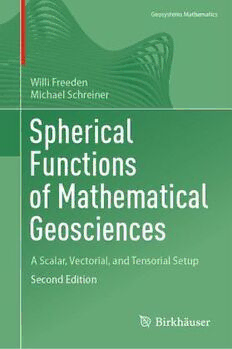Table Of ContentGeosystems Mathematics
Willi Freeden
Michael Schreiner
Spherical
Functions
of Mathematical
Geosciences
A Scalar, Vectorial, and Tensorial Setup
Second Edition
Geosystems Mathematics
Series Editors
Willi Freeden, Mathematics Department, University of Kaiserslautern,
Rhineland-Palatinate, Germany
M. Zuhair Nashed, Mathematics Department, University of Central Florida,
Orlando, FL, USA
Editorial Board
Hans-Peter Bunge, Geophysics, Ludwig Maximilian University of Munich,
München, Bayern, Germany
RoussosG.Dimitrakopoulos,FacultyofEngineering,McGillUniversity,Montreal,
QC, Canada
Yalchin Efendiev, Texas A&M University, College Station, TX, USA
Andrew Fowler, University of Limerick, Limerick, Ireland
Bulent Karasozen, Institute of Applied Mathematics, Middle East Technical
University, Ankara, Turkey
Jürgen Kusche, Institute of Geodesy and Geoinformation, University of Bonn,
Bonn, Nordrhein-Westfalen, Germany
Liqui Meng, Aerospace and Geodesy, Technical University of Munich,
Munich, Germany
Volker Michel, Geomathematics, University of Siegen, Siegen,
Nordrhein-Westfalen, Germany
Nils Olsen, National Space Institute, Technical University of Denmark,
Kongens Lyngby, Denmark
Helmut Schaeben, TU Bergakademie Freiberg, Freiberg, Sachsen, Germany
Otmar Scherzer, University of Vienna, Wien, Wien, Austria
Frederik J. Simons, Department of Geosciences, Princeton University, Princeton,
NJ, USA
Thomas Sonar, Institut für Analysis, Technische Universität Braunschweig,
Braunschweig, Niedersachsen, Germany
Peter J. G. Teunissen, Delft University of Technology, DELFT, Zuid-Holland,
The Netherlands
Johannes Wicht, Max Planck Institute for Solar System Research, Göttingen,
Niedersachsen, Germany
Willi Freeden Michael Schreiner
(cid:129)
Spherical Functions
of Mathematical Geosciences
A Scalar, Vectorial, and Tensorial Setup
Second Edition
Willi Freeden Michael Schreiner
Mathematics Department Institut for Computational Engineering ICE
University of Kaiserslautern Eastern SwitzerlandUniversity
Kaiserslautern, Germany of AppliedSciences
Buchs, Switzerland
ISSN 2510-1544 ISSN 2510-1552 (electronic)
Geosystems Mathematics
ISBN978-3-662-65691-4 ISBN978-3-662-65692-1 (eBook)
https://doi.org/10.1007/978-3-662-65692-1
1stedition:©Springer-VerlagBerlinHeidelberg2009
2ndedition:©TheEditor(s)(ifapplicable)andTheAuthor(s),underexclusivelicensetoSpringer-Verlag
GmbH,DE,partofSpringerNature2022
Thisworkissubjecttocopyright.AllrightsaresolelyandexclusivelylicensedbythePublisher,whether
thewholeorpartofthematerialisconcerned,specificallytherightsoftranslation,reprinting,reuseof
illustrations, recitation, broadcasting, reproduction on microfilms or in any other physical way, and
transmissionorinformationstorageandretrieval,electronicadaptation,computersoftware,orbysimilar
ordissimilarmethodologynowknownorhereafterdeveloped.
The use of general descriptive names, registered names, trademarks, service marks, etc. in this
publicationdoesnotimply,evenintheabsenceofaspecificstatement,thatsuchnamesareexemptfrom
therelevantprotectivelawsandregulationsandthereforefreeforgeneraluse.
The publisher, the authors, and the editorsare safeto assume that the adviceand informationin this
book are believed to be true and accurate at the date of publication. Neither the publisher nor the
authors or the editors give a warranty, expressed or implied, with respect to the material contained
hereinorforanyerrorsoromissionsthatmayhavebeenmade.Thepublisherremainsneutralwithregard
tojurisdictionalclaimsinpublishedmapsandinstitutionalaffiliations.
This book is published under the imprint Birkhäuser, www.birkhäuser-science.com by the registered
companySpringer-VerlagGmbH,DE
Theregisteredcompanyaddressis:HeidelbergerPlatz3,14197Berlin,Germany
Thisbookisdedicatedtothememoryofour
parents,
HubertineandWilhelmFreeden,
HildeandGerhartSchreiner.
Preface
SpecialfunctionsappliedinEarth’ssciencesandgeoengineeringareconfrontedwith
thecomplexityofareal“potato-like”Earthgeometry,thatisastrikingobstaclepar-
ticularlyforallglobalpurposesofmodelingandsimulation.Theobstaclecanonly
beovercometosomeextendintoday’smathematics.Theprinciplestofindawayout
arefoundinasuitabletransitiontoaregularlystructuredgeometryfortheEarth,viz.
a spherical figure. In fact, by modern satellite positioning methods, the maximum
deviationoftheactualEarth’ssurfacefromtheaverageEarth’sradius(6371km)can
bedeterminedtobelessthan0.4%.So,lookingatthespecialfunctionsavailablein
thegeoscientificliteraturetoday,asphericalshapeforpurposesoftheglobalEarthis
usedinalmostallpublications.Althoughamathematicalformulationsimplyusing
sphericalreferencegeometryamountstoastrongrestriction,itisatleastacceptable
foralargenumberofproblems.Thissituationexplainsthestrongneedforspherical
mathematicalstructures,tools,andmethodstohandlegeoscientificallyrelevantdata
sets of high quality within high accuracy and to improve significantly modeling
capabilitiesinEarthsystemresearch.
Standard spherical functions since the time of A.M. Legendre, P.S. de Laplace,
andC.F.Gaussarepolynomialtrialfunctions,conventionallycalledsphericalhar-
monics.Sphericalharmonicsrepresenttheanalogousoftrigonometricfunctionsfor
orthogonal(Fourier)expansionsonthesphere.Theuseofsphericalharmonicsindi-
verseareasofgeosciencesisawell-establishedprocedure,particularlyforanalyzing
scalarpotentialfunctions.Nowadays,referencemodelsfortheEarth’sgravitational
andmagneticpotential,forexample,arewidelyknownbytablesofexpansioncoef-
ficients,i.e.,thefrequencyconstituentsoftheirpotentials.
Inthisrespectitshouldbementionedthatvectorialandtensorialpotentials–even
in a spherical Earth’s reference model – have their own nature. Concerning the
mathematicalmodeling ofvector andtensor fields,one isusually notinterested in
theirseparationintoscalarCartesiancomponentfunctions.Instead,inherentphysical
propertiesshould beobserved,for example,theexternal gravitationalfieldis curl-
free,themagneticfieldisdivergence-free,theequationsforincompressibleflow,i.e.,
vii
viii Preface
theNavier-Stokesequations,implydivergence-freevectorsolutions.Inaspherical
nomenclature as intended in our approach, all these physical constraints result in
a formulation by certain operators like the surface gradient, surface curl gradient,
surface divergence, surface curl, etc. So, the types of vector and tensor spherical
harmonicsasproposedheresatisfyadequaterequirementsofsplittingavectorialor
tensorial signal into geoscientifically relevant components, thereby avoiding artifi-
cialsingularitiesarisingfromtheuseoflocalcoordinates.Basicallytwotransitions
areundertakeninourapproachtosphericalharmonics,firsttheextensionfromthe
scalartothevectorialcaseisstrictlyrealizedunderphysicalconstraintsandsecond
thedefinitionofLegendrefunctionsiscanonicallydescribedunderthephenomenon
oftherotationalinvarianceonthesphere.TheLegendrefunctionsactasconstituting
elementsforzonalfunctions,i.e.,one-dimensionalfunctionsonlydependingonthe
polardistanceoftheirtwoarguments.Allinall,theconceptofsphericalharmonics
playsthecentralroleinageomathematicalpresentationofspecialfunctionsreflect-
ingthesignificanceofapolynomialnatureinasphericallyshapedglobalEarth.In
addition,sphericalharmonicsformthecanonicalcandidatestorepresenttheangular
partinaradial/angulardecompositionofsolutionsystemsforLaplace,Helmholtz,
Cauchy-Navier,(pre-)Maxwell,andNavier-Stokesequations.
Our purpose in this work is to present a textbook that allows the reader to con-
centrateonspecialfieldssuchasthegeosphere,hydrosphere,atmosphere,andalso
anthroposphere.Inotherwords,thespecialfunctionstobediscussedvarystrongly,
dependent on the specific observation and measurement indicators (e.g., in gravi-
tation,magnetics,deformation,climate, fluidflow,etc.)andonthe occurringfield
characteristics (e.g., as potential field, diffusion field, wave field). Obviously, the
differential equation under consideration determines the type of special functions
thatareneededinthedesiredreductionprocess.
Thebookistoserveasaself-consistentintroductorytextbookfor(graduate)students
ofmathematics,geosciences,andgeoengineering.Inaddition,theworkshouldalso
beavaluablereferenceforscientistsandpractitionersfacingsphericalproblemsin
theirprofessionaltasks.Thepresentsecondeditionisbasedonessentialpartsofthe
firsteditionpublishedintheyear2009intheSpringerseries“AdvancesinGeophysi-
calandEnvironmentalMechanicsandMathematics”(𝐴𝐺𝐸𝑀2).Evidently,thisfirst
edition forms the fundamental foundation for the present book. However, updates
and additions were indispensable. The present version thus claims to present the
theoryofsphericalfunctionsonthebasisoftoday’sessentialideasandconcepts,but
completelyfreeofspecificconcretetemporaleventsofpast,present,andfuture.The
resultisaworkwhich,whilescientificallyreflectingthepresentstateofknowledge
inatime-relatedmanner,neverthelessclaimstobeoflargelytimelesssignificance
for(geo-)mathematicalresearchandteaching.
TheauthorsthankM.Z.Nashed,Orlando,foracceptingthebookforpublicationin
theseries“GeosystemsMathematics”.TheyareobligedtothankH.Nutz,Kaisers-
lautern, for reading carefully all parts of the book and giving valuable comments.
Preface ix
Finally,theauthorswouldliketothankBirkha¨user,inparticularT.Hempfling,M.
Peters,andL.Kunzfortheirobligingnessandcooperation.
KaiserslauternandBuchs, WilliFreeden
May2022 MichaelSchreiner

